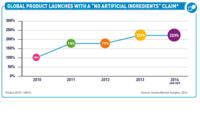MarketWatch -- June 2010
The effort was so successful that DEWmocracy 2 is now underway, with three new Dew flavors (Distortion: Dew with lime; Typhoon: Dew with tropical flavors; and White Out: Dew with citrus). Now on market shelves, all three are the result of “a partnership...with 4,000” of the “DEW brand’s most loyal fans.”
Footprints in the Sand
Sustainability efforts in the food industry have run the gamut, from reducing the carbon footprint of transporting foods and beverages, to biodegradable packaging, even to recent announcements of edible packaging innovations. However, a recent introduction takes the move a step further, by promising it is actually carbon-negative.
According to Roastery 7, it takes 4lbs of carbon (on average) to produce one pound of coffee. So, for every pound of its Tiny Footprint Coffee consumers purchase, the company contributes to Ecuador’s Mindo Cloudforest Foundation, which then plants “carbon-sucking trees that each suck up 54lbs of carbon from the environment.” This, the company claims, results in a 50lb carbon reduction.
As for the taste of the coffee, the company explains the flavor experience: “One that mixes the deep, sensual tastes of hand-crafted coffee with the power of doing something good and right for our planet.”
Going to the Wellness
The notion of pet foods with a healthy slant is not a new phenomenon; “Helps build strong teeth and bones” became a catchphrase in pet foods years, if not decades, ago. However, recent pet food introductions have capitalized on the trends human consumers face themselves. So, natural has become a positioning, as evidenced in the Wellness Stews line from Wellness Natural Foods for Pets. These canned “meals for dogs” feature three grain-free varieties (beef stew with carrots and potatoes, chicken stew with peas and carrots, and turkey and duck stew with sweet potatoes and cranberries), as well as such other items as turkey stew, venison and salmon stew, and lamb and beef stew. All products promise the ingredients are natural, whole foods, providing “exceptional nutrition,” vitamins, minerals and antioxidants, and they do not have wheat or wheat gluten, corn or soy.
Front and Center
The FDA is asking for “comments and information from the public and other interested parties about front-of-package nutrition labeling and on-shelf tags in retail stores.” The measure is part of an effort to improve the usefulness of point-of-purchase (POP) nutrition information.
Specifically, the FDA is interested in learning how much consumers notice, utilize and understand the nutrition symbols on front-of-pack labels and shelf tags. In addition, it hopes to learn more about research that has compared various approaches to these labels, as well as any graphic design, marketing or advertising data that will serve to promote better POP nutrition information.
Comments will be accepted until July 28, 2010, at www.regulations.gov. Enter “Docket No. FDA-2010-N-0210.”pf
Looking for a reprint of this article?
From high-res PDFs to custom plaques, order your copy today!





